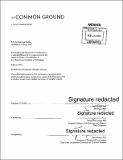unCommon ground
Author(s)
Miranowski, David (David Kelly)
DownloadFull printable version (23.86Mb)
Alternative title
Uncommon ground
Other Contributors
Massachusetts Institute of Technology. Department of Architecture.
Advisor
Rafael (Rafi) Segal.
Terms of use
Metadata
Show full item recordAbstract
Brooklyn's urban fabric is a redundant array of perimeter residential blocks, built out over the last 200 years as a layered accretion. Within each block is a core that is spatially unified yet distinct from the public front of the street. These spaces are defined by their enclosure yet this barrier is not entirely impenetrable. Each block possesses a few unique moments of slippage in which the perimeter mass opens up to reveal a slivered view into the depths, and potentials, of this internalized world. To the vast majority, including residents, these slivers and cores remain a visual phenomenon. The near-universal practice of extruding backyard parcel lines has created an architecture of division, namely the fence, closing off the yard from the block and the block from the neighborhood. This thesis proposes an alternative scenario, in which rear fences are removed and a thin line of public space is inserted into the mosaic of existing yards. The line, activated through a set of calibrated relationships with the ground and floating infrastructure, stitches together people within the open core and works against the detritus of old divisions. Through this intervention, a new grain emerges which connects Brooklyn's blocks and transforms the residual slivers into a network of spaces that open to an engaging, and unexpected, rendering of the pre-existing.
Description
Thesis: M. Arch., Massachusetts Institute of Technology, Department of Architecture, 2015. Cataloged from PDF version of thesis. Includes bibliographical references (page 129).
Date issued
2015Department
Massachusetts Institute of Technology. Department of ArchitecturePublisher
Massachusetts Institute of Technology
Keywords
Architecture.